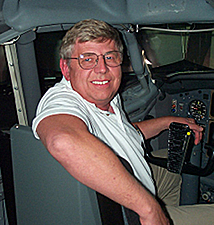Do You Remember How to Dance?
By Michael “Mick” Kaufman
I feel it is extremely important for a pilot to hand-fly a precision approach down to minimums. I ask, “Can they keep the localizer and glideslope needles within the two-degree circle on the CDI indicator or HSI?” Now, let’s add in a gusty 30-knot crosswind: “CAN THEY DANCE”? It is a skill to be able to fly an approach with such tight tolerances and in very turbulent conditions.
I am currently training a new instrument pilot for his instrument rating, and yesterday he showed me that he learned to “dance” as conditions were as I described them above.
First, this requires an excellent instrument scan, and, by the way, the airplane had “steam gauges”. You all remember those round gauges with pointers. With a good scan and the proper input on the controls, this instrument student was able to fly an ILS approach to minimums with two degrees’ needle deflection of both the localizer and the glideslope. This student instrument pilot can out-fly most two-axis autopilots in extremely turbulent air.
So I ask our readers if they could still hand-fly an approach in these conditions.
It is important to have a good scan, and it is equally important to have the proper control input, so as to not overcompensate for needle deflections. If you were able to watch the control inputs, you would see that the yoke and rudder pedals are constantly moving — probably several times a second with small corrections.
If you had a good three-axis autopilot, you would see the same type of movement. My V-tail Bonanza has an S-TEC 50 autopilot with the yaw damper; you can watch or feel those rudder pedals “DANCE” in turbulent air.
Almost 30 years ago, I took a Bonanza training course, and my instructor happened to be the “Godfather” of Bonanza training, Bill Hale. After flying with me and filling out my pilot logbook, Bill commented; “I see you are a flight instructor, how would you like to instruct in our program”? Bill introduced me to the program manager, Sam James, and the rest is history. I guess Bill was impressed with my ability to fly an approach on that turbulent day.
As the purpose of this article is to improve pilot skills, it is important to cover some basics of instrument flying skills. One of the questions asked on the quiz associated with the curriculum I use when doing an instrument rating is “What are the two most important items in instrument scan?” Answer: “fixating on or omitting an instrument.” There is no ideal scan for a specific situation, and pilots must develop a technique that works for them. Eventually, a pilot who does a lot of hand-flying on instruments, no longer looks at individual instruments but sees his panel as one big instrument. In the late 1980s, I was heavily involved in the Civil Air Patrol, as chief check pilot and stan-eval officer for the Wisconsin Wing. I was privileged to have a gentleman named Dan Donavan as my deputy.
Dan was an airline pilot and test pilot for Douglas Aircraft and revealed a study that he had been involved in during the early development of the glass cockpit. It was found that pilots using tape readouts of altitude and airspeed required more processing power by the brain than using conventional gauges with pointers. An example he cited was where racecar drivers often go to the extreme of rotating their gauges, so the pointers are in a vertical position when the oil pressure is where it should be. Pilots can interpret those pointers more easily than reading a number — and they can react more quickly to an undesirable reading.
Today, many aircraft have digital tape readouts on their primary flight display; however, the autopilot is flying most of the time, and the pilot’s workload and the use of brainpower to convert numbers to a control input is reduced. When I am on an approach and look at that old familiar airspeed indicator, I know where the pointer should be. I don’t read the number as I know that if the pointer is in that position; the number I want is under it – and the same is true with the altimeter.
Autopilots are like pilots in many ways, as the pilot “does his or her dance” with the control yoke and rudder pedals, the autopilot must dance, as well.
In certifying an autopilot in an aircraft, the manufacturer of the autopilot must create software to meet the “dance” requirements of the aircraft it is to be installed in. An S-TEC 50 autopilot coming out of a Cessna 182 will not work well in an A36 Bonanza. The outputs will not match the outputs required by the Bonanza, so beware of that bargain autopilot for sale on eBay if it did not come out of an identical model of airplane. It will dance a polka when you need a waltz.
In the last several years, I have seen pilots upgrading their avionics – and avionics shops are booking new installs up to six months out. In many cases, the pilot wants to keep costs down by trying to interface legacy equipment with new state-of-the-art avionics. It simply does not work; the avionics tech and pilot spend countless hours trying to fix the problem, and it eventually leads to the pilot selling the airplane in despair to some unsuspecting new owner.
If your avionics equipment is all working well together, and you don’t have the dollars to get a proven package that plays well together, forget the partial upgrade.
It is important that a pilot can dance on the controls to get desired results when hand-flying an approach; however, it is just as important that your avionics dance in sync with its partner avionics.
Fly safe and I’ll see you again in the next edition of “Captain’s Corner.”




